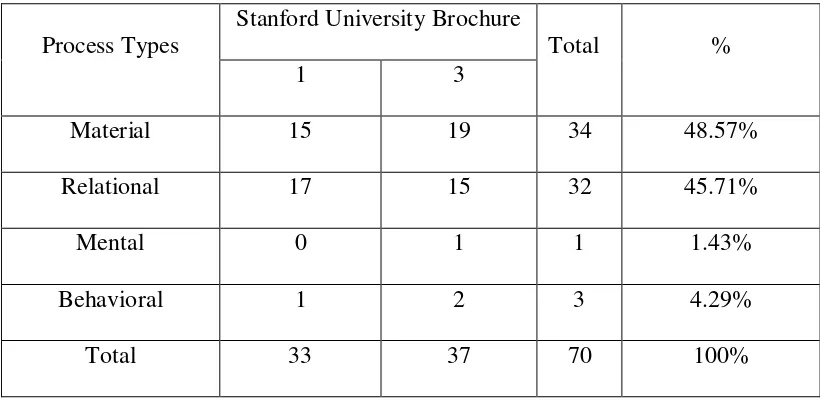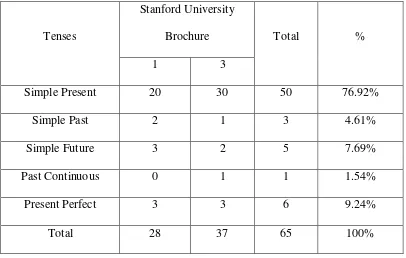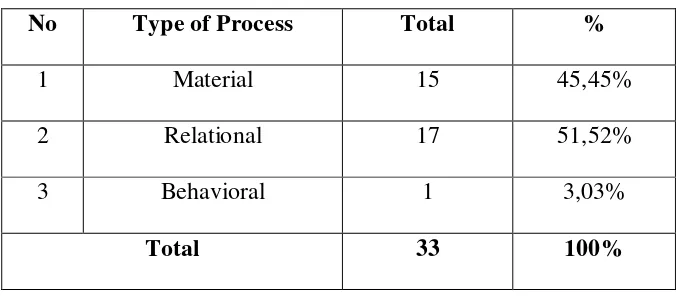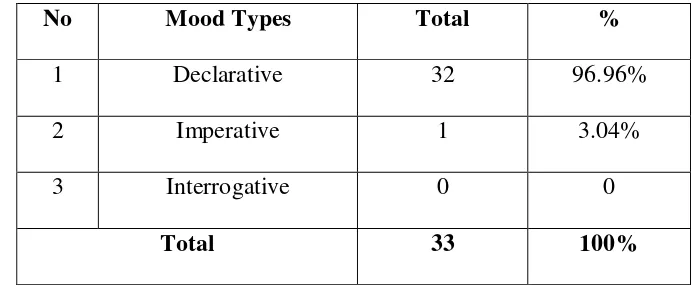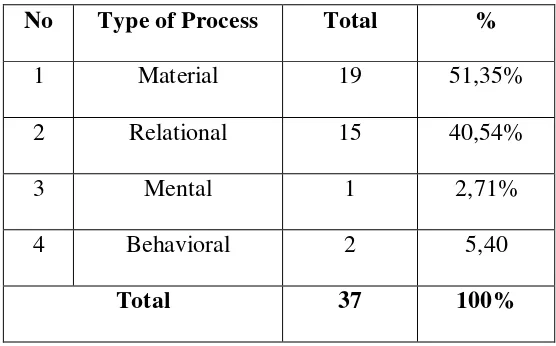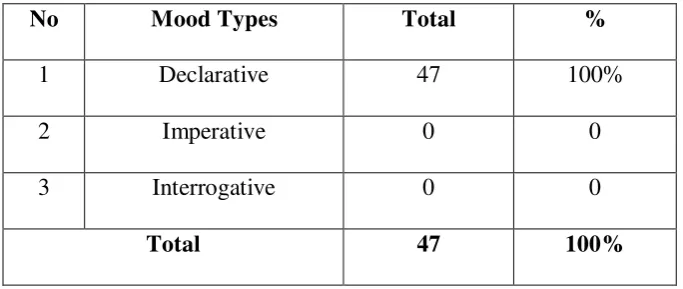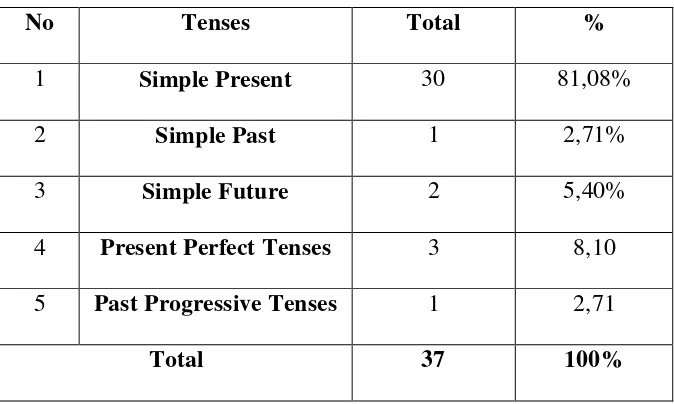33
This chapter tells about the results of the data analysis in order to answer the problem of this research. The framework used to analyze the data is proposed by Gerot and Wignell (1994: 192). The statements of the problem are addressed to find out what kinds of social function, what kinds of schematic structure, and what kinds of lexicogrammatical described in genre.
4.1 The Findings of Stanford University Brochures
In this research, the researcher had 2 Stanford University Brochure as the data. The data of this research were taken from Stanford University Brochure especially Stanford Graduate School of Business. There are two brochures from two programs in Stanford Graduate School of Business. They are Advanced Leadership Program for Asian-American Executives and Executive Program for Women Leaders. Each of Stanford University Brochures has similarity in form.
Table 4.1 Parts of Stanford University Brochures
Parts of Brochure
Stanford University Brochures
1 2
Headlines
Supplementary information
Introduction the product
Justifying the product
Establishing credentials -
Reader Attraction
Targeting the market
Describing the product
User endorsement
Additional Information
Value of the product
Soliciting response
For linguistics features, the researcher focused on process types, mood types, and tenses. After the data were divided into clauses, the researcher found 70 clauses from two brochures. Halliday as cited in Gerot and Wignell (1994: 54), asserts that there are seven different process types; material, behavioral, mental, verbal, relational, existential, and meteorological.
[image:3.595.107.517.380.581.2]The following table 4.2 shows the process types of the data which is total 70 clauses, it would be analyzed and mention more detailed for each process type. It can be seen on the table 4.2 below:
Table 4.2 Process type of Stanford University Brochure
Process Types
Stanford University Brochure
Total %
1 3
Material 15 19 34 48.57%
Relational 17 15 32 45.71%
Mental 0 1 1 1.43%
Behavioral 1 2 3 4.29%
Total 33 37 70 100%
indicated by process of doing. Process of material can be seen from several verbs: grow, put, learn, mix, apply, analyze, etc. The other occurrence of process types are relational process occurs 32 times (45.71%), mental process occurs 1 times (1.43%), and the last is behavioral process which is occurs also 3 times (4.29%).
[image:4.595.107.513.349.607.2]The following table 4.3 covers the tenses of the data which is total 65 sentences analyzed and followed by more detailed for each tenses type. It can be seen in table 4.3 below:
Table 4.3 Classifying Tenses on Stanford University Brochure
Tenses
Stanford University
Brochure Total %
1 3
Simple Present 20 30 50 76.92%
Simple Past 2 1 3 4.61%
Simple Future 3 2 5 7.69%
Past Continuous 0 1 1 1.54%
Present Perfect 3 3 6 9.24%
Total 28 37 65 100%
dominant tenses in the brochure which occurs 50 times and the percentage is (76.92%). Simple present tense can be identified as a dominant tense, because it express action or state in the present time and is used to say something happens all the time or repeatedly, or that something is true in general. Simple present can be seen from several verbs, which is used the simple form of verb [am/is/are] + [V1= future verb]: include, build, comprise, etc.
The other occurrence of tenses are simple past occurs 3 times (4.61%), simple future occurs 5 times (7.69%), past continuous once (1.54%), and present perfect 6 times (9.24%).
The findings of each Stanford University Brochure which mention as follow:
4.2 The discussion of first Stanford University Brochure (Advanced Leadership Program for Asian-American Executives)
4.2.1 Social function of Advanced Leadership Program for Asian-American Executives Brochure
The social function of the brochure is to inform and promote Advanced Leadership Program for Asian-American Executives, which would be arranged on October 20-25, 2013, this is one of programs from Stanford Graduate School of Business Executive Education Programs. This program has purpose to prepare Asian executives for senior leadership roles, so in advance the companies address tomorrow‟s challenges and seize global business opportunities.
The schematic structure of this brochure is: Headlines ^ Supplementary information ^ Introduction the product ^ Justifying the product ^ Establishing credentials ^ Reader Attraction ^ Targeting the market ^ Describing the product ^ User endorsement ^ Additional Information ^ Value of the product ^ Soliciting response
1. Headlines
The existence of headlines is important. It shows the term or identity of brochure. That is the reason why headlines is one of the important parts mentioned in brochure. Reading the headlines of the brochure will be clearly to identify the kind of the brochure. In this brochure it can be seen by mentioning of university named and program named that show the identity of the program that offer in this brochure. This stage is seen in the following:
EXECUTIVES”, the word Program becomes the head word of the phrase and the other words become additional information.
2. Supplementary information
This part provides information about detail of the product. In this brochure, it shows by mentioning when the program can be offered and how much it costs. This stage is seen in the following:
The data above shows requirements of the product, it consist of the dates of the program, the tuition fee and the application deadline. This program will be held on July 28th-August 2nd 2013 and the cost is $10,500. If the participants would join in this program they have to send the application before 24th June 2013.
3. Introduction the product
From the data above, the paragraph explains that Advanced Leadership Program for Asian-American Executives is an executive training program for Asian senior executives.
4. Justifying the product
This move offers the product or service to the readers by indicating the importance of the product or need of the product or service. This stage is seen in the following:
The characteristic of justifying the product is by mentioning the important things of the product. Based on the data, the program offer many advantages, such as this program would help companies address tomorrow‟s challenges, and this program teach strategies for leading in dynamic.
5. Establishing credentials
include in this program. There are 19 companies join in this program which shows a good reputation of this program. This stage is seen in the following:
Based on the data, the nineteen companies show that this program has cooperation with great companies. The cooperation indicates that this program has a well reputation and trustworthy program.
6. Reader Attraction
This part involves pictures that appear in brochure. Every picture has meaning which want to tell to readers. Picture has function to attract reader attention. In this brochure there is a picture that illustrated as a man which is taking an attention of something. This stage is seen in the following:
executive. So to attract Asian people attention, this brochure used an Asian man as the model of this brochure.
7. Targeting the market
This part provides who should attend this program. It shows the target of the market. In this brochure, it is shown by mentioning every details for participants who want join. This stage is seen in the following:
The characteristics of targeting the market in this brochure mentions who should attend in this program. Top level management (functional director, vice president) invited to attend this program.
8. Describing the product
Two parts above show details of the program. The first part show the example of daily schedule from this program and the second part show the difference participants who can join in this program, they come from different management function, industry and region.
9. User endorsement
This stage has a specific characteristic, it use past tenses because this part show the comment from people who ever joint in this program. Past tense just found in this stage.
10. Additional Information
The data above shows the faculty directors and other Stanford graduate school of business faculty. This brochure mentions faculty directors to show that this program has competent persons joint in the program, so people can believe and want to join it.
11. Value of the product
From the data above, it can be seen that the paragraph explain about the value of the program. Participants who joint in Advanced Leadership Program for Asian-American Executives would get knowledge and experience to increase their ability that would be applied in their companies. 12.Soliciting response
This move functions to encourage the readers or prospective customers to continue further information. The move may appear in the form of a specified telephone number and/or the name of the person who can be contacted to enquire about the product or service. This stage is seen in the following:
The characteristic of soliciting response is a contact person that mentioned. It has function to make participants who want to join in this program easier to contact the Courri Brady as the Associate Director, Programs and Marketing.
4.2.3.1 Process found of first brochure (Advanced Leadership Program for Asian-American Executives Brochure)
Table 4.4 Process found in Advanced Leadership Program for Asian-American Executive Brochure
No Type of Process Total %
1 Material 15 45,45%
2 Relational 17 51,52%
3 Behavioral 1 3,03%
Total 33 100%
Processes are realized by verbs. Traditionally verbs have been defined as „doing words‟. But the above list indicates that some verbs are not doing words at
all, but rather express states of being or having. In this analysis the researcher found 3 types of processes: material, relational, and behavioral.
The researcher covers that relational process is the most dominant process in the first brochure, which occurs 17 times and the percentage is 51.52%. Relational process can be identified as the dominant process, because verb is indicated by process of being mostly. Relational process has function to give information about the program, and it gives appeal for participant to take this program.
[image:15.595.145.485.212.361.2]There are 15 material process found in the first brochure. The examples of material process are:
a. This program helps companies address tomorrow’s challenges and seize
global business opportunities (4th line in second paragraph of justifying the product)
This clause shows the material process, it can be seen from a verb helps in the clause. It means that the material process constructs process of doing. The verb helps explain that Advanced Leadership Program for Asian-American Executives gives advantages companies in address tomorrow‟s challenges.
b. His recent work investigates the role of social movements as motors of
organizational change in professional and organizational fields (3rd line of additional information)
This clause shows the material process, it can be seen from a verb change in the clause. It means that the material process constructs process of doing. The verb change tells that recent work of Hayagreeva Rao get the differences after he made an investigation, the role of social movements as motors of organizational become different in organizational fields.
2. Relational Process
There are 17 material process found in the first brochure. The examples of relational process are:
a. Tuition includes accommodations, meals, and materials (5th line of supplementary information)
This clause gives an example of relational process produces. It covers that the letter produces relational-attributive process. The verb includes explain that tuition covers all things like accommodation, meals and also materials.
b. The Advanced Leadership Program for Asian-American Executives is the first
program to address the apparent gap in effective executive training for
high-achieving Asian executives (1st line of introduction the product)
This clause gives an example of relational process produces. It covers that the letter produces relational-attributive process. It is indicated by applying finite is. The finite explains that Advanced Leadership Program for Asian-American Executives is an executive training program for Asian senior executives.
c. This is not a program (1st line of user endorsement)
3. Behavioral Process
a. As companies look to Asia for future growth (2nd line of justifying the product) The example above shows behavioral process, a process of psychological behavior. It can be seen from the verb look. In the clause, companies always watch to Asians which is high contributors to U.S and Asian is one of the best increasing of consumer base in the future.
4.2.3.2 Mood Types found of first brochure (Advanced Leadership Program for Asian-American Executives Brochure)
Table 4.5 Mood Types found in Advanced Leadership Program for Asian-American Executive Brochure
No Mood Types Total %
1 Declarative 32 96.96%
2 Imperative 1 3.04%
3 Interrogative 0 0
Total 33 100%
Mood in English is realized by the position in the clause of the subject and finite. Indicative mood is realized by the features subject + finite. The order of the subject and finite realizes declarative and interrogative. The dominant mood type of the clauses is declarative mood because the clauses tell about the program that promote in brochure. Moreover, the structure of every sentence in this brochure is started by subject then followed by finite.
[image:18.595.161.507.390.533.2]According to the statement above, the sentence show declarative mood. It can be seen that the program gives statement by saying. The one-week Advanced Leadership Program has been a great venue to revisit leadership
attributes and growth with the Asian context. It means that Advanced Leadership Program for Asian-American that would be arranged for one week would be a great experience to all participants which can increase their leadership attribute and also growth their knowledge about Asian. Declarative mood here uses present perfect tenses.
2. Please contact Courri Brady. Associate Director, Programs and Marketing.
According to the statement above, the sentence show imperative mood. It can be seen that the program gives statement by saying. Please contact Courri Brady. Associate Director, Programs and Marketing. It means that if participant want to get more information or to apply this program they have to contact Coury Brady as Associate Director, Programs and Marketting. Imperative mood here uses present perfect tenses.
4.2.3.3 Tenses found of first brochure (Advanced Leadership Program for Asian-American Executives Brochure)
No Tenses Total %
1 Simple Present 20 71,43%
2 Simple Past 2 7,15%
3 Simple Future 3 10,71%
4 Present Perfect 3 10,71%
Total 28 100%
The tenses used in this text are simple present tenses, simple past tenses, simple future tenses, and present perfect tenses. The researcher covers that simple present tense is the most dominant tense in the brochure which occurs 20 times and the percentage is 71,43%. Simple present tenses can be identified as the dominant tenses, because it express action or state in the present time and it is used to say something happens all the time or repeatedly, or that something is true in general. Simple present can be seen from several verbs, which is used the simple form of verb [am/is/are] + [V1= future verb]: include, build, comprise, etc.
1. Simple present tense expresses an unchanging, repeated, or reoccurring action or situation that exists only now. It can also represent a widespread truth. With the simple form of the verb [am / is / are] + [verb]
a. This programs helps companies address tomorrow’s challenges b. Who holds a position representing the highest 3% to 4% of their
2. Simple past tense expresses an action or situation that was started and finished in the past. Most past tense verbs end in –ed. With the simple form of the verb [verb + ed]
a. The high-power presentations, panel discussion, and in particular the work group discussions were most insightful.
b. And during the evenings we had opportunities to hear from and dialogue with C-suite Asian executives and senior HR professionals to get their perspectives on what we need to consider and to act on to advance our careers
3. Simple future tense expresses an action or situation that will occur in the future. This tenses is formed by using will/shall, with the simple form of the verb [will] + [verb1]
a. a leadership pipeline of Asian executives will be best positioned to innovate and grow globally
b. Program participants will include mostly high-level Asian executives
4. Present perfect tense is tells something about the present. It is used to give information or to announce a recent happening. The simple form of verb [have/has] + a past participle.
a. Asians have found it difficult to reach the highest levels of organizational leadership
4.3 The discussion of second Stanford University Brochure (Executive Program for Women Leaders)
4.3.1 Social function of Executive Program for Women Leaders Brochure
The social function of the brochure is to inform and promote Executive Program for Women Leaders, which would be arranged on May 5-10, 2013, this is one of programs from Stanford Graduate School of Business Executive Education Programs. This program has purpose to gives women executives opportunities, to explore frameworks and tactics to achieve their goals in dynamic work environment.
4.3.2 Schematic structure of Executive Program for Women Leaders Brochure
The schematic structure of this brochure is: Headlines ^ Supplementary information ^ Introduction the product ^ Justifying the product ^ Establishing credentials ^ Reader Attraction ^ Targeting the market ^ Describing the product ^ User endorsement ^ Additional Information ^ Value of the product ^ Soliciting response
1. Headlines
mentioning of university named and program named that show the identity of the program that offer in this brochure. This stage is seen in the following:
The characteristic of headlines is used a nominal group, it can be seen from the university named of the data “STANFORD GRADUATE SCHOOL
OF BUSINESS”, the word Stanford become the head word of the phrase and the other words become additional information. From the program named “EXECUTIVE PROGRAM FOR WOMEN LEADERS”, the word Program
becomes the head word of the phrase and the other words become additional information.
2. Supplementary information
This part provides information about detail of the product. In this brochure, it shows by mentioning when the program can be offered and how much it costs. This stage is seen in the following:
would join in this program they have to send the application before 5th April 2013.
3. Introduction the product
This move presents the purpose of the product. From the data the reader can get the illustration about the program that offer in this brochure. This stage is seen in the following:
From the data above, the paragraph explains that Executive Program for Women Leaders gives women executives opportunities, to explore frameworks and tactics to achieve their goals in dynamic work environment. 4. Justifying the product
The characteristic of justifying the product is by mentioning the important things of the product. Based on the data, the program offers that it has a good lectures and a program. It includes interactive exercise and leadership diagnostics, which can explore the critical areas of negotiation, communication, social networks and team effectiveness for all participants who join in this program.
5. Reader Attraction
attention. In this brochure there is a picture that illustrated as a women brings a paper who is discussing something with her friend. This stage is seen in the following:
The picture illustrated two women executive. It represents the target of the brochure, because the target of the program is woman executives. So to attract women attention, this brochure used two women as the model of this brochure.
6. Targeting the market
The characteristics of targeting the market in this brochure mentions who should attend in this program. Top level management (functional managers) invited to attend this program.
7. Describing the product
This move offers the product and gives information to the readers about the most essential details of the product like how this program would going on. This stage is seen in the following:
8. User endorsement
This move involved information which is told by people who ever used the product or service. People who ever join in this program give their comments how this program going on, and what the advantages after they join in this program. This stage is seen in the following:
This stage has a specific characteristic, it use past tenses because this part show the comment from people who ever joint in this program. Past tense just found in this stage.
9. Additional Information
The data above shows the faculty directors and other Stanford graduate school of business faculty. This brochure mentions faculty directors to show that this program has competent persons who joint in it, so people can believe and want to join it. In this part also explain about Building Alliances which participants will get if they join it.
10.Value of the product
From the data above, it can be seen that the paragraph explain about the value of the program. Participants who joint in Executives Program for Women Leaders would get knowledge and experience to increase their ability that would be applied in their companies.
11.Soliciting response
This move functions to encourage the readers or prospective customers to continue further information. The move may appear in the form of a specified telephone number and/or the name of the person who can be contacted to enquire about the product or service. This stage is seen in the following:
4.3.3 Linguistic Features of Executive Program for Women Leaders Brochure
[image:31.595.238.516.279.452.2]4.3.3.1 Process found of second brochure (Executive Program for Women Leaders Brochure)
Table 4.7 Process found in Executive Program for Women Leaders Brochure
No Type of Process Total %
1 Material 19 51,35%
2 Relational 15 40,54%
3 Mental 1 2,71%
4 Behavioral 2 5,40
Total 37 100%
Processes are realized by verbs. Traditionally verbs have been defined as „doing words‟. But as the above list indicates, some verbs are not doing
words at all, but rather express states of being or having. In this analysis the researcher found 4 type processes: material, relational, mental and behavioral.
The researcher covers that material process is the most dominant process in the second brochure, which occurs 19 times and the percentage is 51.35%. Relational process can be identified as the dominant process, because verb is indicated by process of doing mostly. Material process has function to persuade and attract people to join this program.
1. Material Process
There are 19 material process found in the third brochure. The examples of material process are:
a. The executive program for women leaders explores the critical areas of
negotiation, team effectiveness, power and relationship, social networks
and influence, and communication. (1st line of justifying the product) This clause shows the material process, it can be seen from a verb explores in the clause. It means that the material process constructs process of doing. The verb explores explain that this program will increase the ability and capability of all the participants who join in this program. b. to help me put together my professional experiences (2nd line of user
endorsement)
This clause shows the material process, it can be seen from a verb put in the clause. It means that the material process constructs process of doing. The verb put tells that Saskia Groen can increase her experience by joining in this program.
c. This unique program gives women executives opportunitie (3rd line of introduction the program)
This clause shows the material process, it can be seen from a verb gives in the clause. It means that the material process constructs process of doing. The verb gives tells that participant would get executives opportunities if they joint this program.
There are 15 material process found in the third brochure. The examples of relational process are:
a. While strategic leadership is the key theme of the program
This clause gives an example of relational process produces. It covers that the letter produces relational-attributive process. It is indicated by applying finite is. The finite explains that strategic leadership shows the key theme of the program.
b. and provides guidelines for both improving their own communication style
and recognizing the unique styles of others
This clause gives an example of relational process produces. It covers that the letter produces relational-attributive process. It is indicated by applying verb provides. The verb provides explain that this program would give an improving in communication style and unique style.
c. Last year’s program highlights included a talk by Dr. Condoleezza Rice
and senior leaders from Sequola Capital and SRI International
This clause gives an example of relational process produces. It covers that the letter produces relational-attributive process. The verb included explain that a talk by Dr. Condoleezza Rice and senior leaders from Sequola Capital and SRI International become the highlights program last year.
3. Mental Process
a. Women understand common business challenges into carees-building opportunities
The example above shows mental process. It can be seen that produce the verb understand. This verb shows how people affect or feel something. In this clause, women have a good common business challenges in opportunities of carees -building.
4. Behavioral Process
There are 2 material process found in the third brochure. The examples of relational process are:
a. when I was looking for something
The example above shows behavioral process. It can be seen from a verb look. The verb shows behavioral process or process of psychological. This clause explains that Saskia Groen do behavioral process “look” of
something.
[image:34.595.168.510.611.755.2]4.4.3.2 Mood Types found of third brochures (Executive Program for Women Leaders Brochure)
Table 4.8 Mood Types found in Executive Program for Women Leaders Brochure
No Mood Types Total %
1 Declarative 47 100%
2 Imperative 0 0
3 Interrogative 0 0
Mood in English is realized by the position in the clause of the subject and finite. Indicative mood is realized by the features subject + finite. The order of the subject and finite realizes declarative and interrogative. The mood type of all the clauses is declarative mood because the clauses tell about the program that is promoted in the brochure. Moreover, the structure of every sentence in this brochure is always started by subject then followed by finite.
1. This session covers the importance of exerting influence in small groups even when there may be little or no authority to do so participants will analyze effective influence tactics and develop multiple perspective on how to gain leverage through dynamic interactions with others
According to the statement above, the sentence shows declarative mood. It can be seen that there is a statement which saying. This session covers the importance of exerting influence in small groups even when there
may be little or no authority to do so participants will analyze effective
influence tactics and develop multiple perspective on how to gain leverage
through dynamic interactions with others. It means that in this session, the program offers some activities during the program, like the participants would be invited to analyze effective influence tactics and develop multiple perspective on how to against leverage in dynamic interactions with other people.Declarative mood here uses simple present tenses.
According to the statement above, the sentence show imperative mood. It can be seen that the program gives statement by saying. Please contact Sara Fernande. Associate Director, Programs and Marketing. It means that if participant want to get more information or to apply this program they have to contact Sara Fernande as Associate Director, Programs and Marketting. Imperative mood here uses present perfect tenses.
4.4.3.3 Tenses found of third brochures (Executive Program for Women Leaders Brochure)
Table 4.9 Tenses found in Executive Program for Women Leaders Brochure
No Tenses Total %
1 Simple Present 30 81,08%
2 Simple Past 1 2,71%
3 Simple Future 2 5,40%
4 Present Perfect Tenses 3 8,10
5 Past Progressive Tenses 1 2,71
Total 37 100%
[image:36.595.179.516.388.590.2]something happens all the time or repeatedly, or that something is true in general. Simple present can be seen from several verbs, which is used the simple form of verb [am/is/are] + [V1= future verb]: include, build, comprise, etc.
1. Simple present tense expresses an unchanging, repeated, or reoccurring action or situation that exists only now. It can also represent a widespread truth. With the simple form of the verb [am / is / are] + [verb]
a. and the concepts of psychology to help participants use their own personality to develop the characters
b. this unique program gives woman executives opportunities to explore frameworks and tactics to achieve their goals in dynamic work environments
2. Simple past tense expresses an action or situation that was started and finished in the past. Most past tense verbs end in –ed. With the simple form of the verb [verb + ed]
a. attending a course at Stanford came at a time in my life
3. Simple future tense expresses an action or situation that will occur in the future. This tenses is formed by using will/shall, with the simple form of the verb [will] + [verb1]
a. participants will analyze effective influence tactics
b. newly appointed mid-level and senior-level managers leading teams
with direct reports will also benefit, as will women entrepreneurs and
4. Present Perfect Tenses tells something about the present. It is used to give information or to announce a recent happening. The simple form of verb [have/has] + a past participle
a. the course content , the quality of the faculty, and the learning from my
fellow participants have contributed to an experience that I will keep
with me for life
b. This program has been an incredible, transformative experience
c. The world-class faculty, research-driven curriculum, and interactive,
hands-on approach have given me tremendous new insights into
effective management
5. Past Progressive Tenses is to talk about something which was happening at or around the time of speaking in the past. The simple form of verb [was/were] + V-ing

